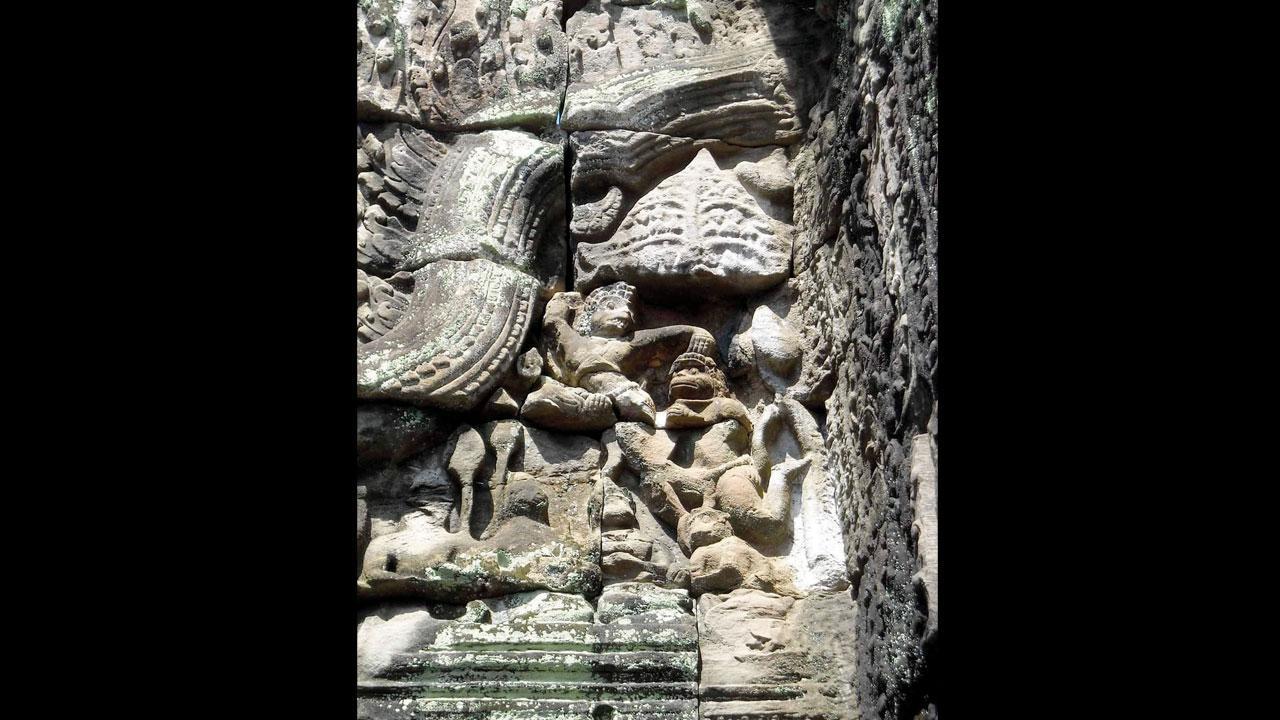UNESCO’s recent pat on the back for Cambodia’s efforts to support its heritage comes as no surprise. India can actually pick up lessons from the tiny South East Asian nation

Hanuman at Preah Kahn, Angkor Wat
 “You are from Indiyeaaah! Aahhh, nice to see you here,” a woman guide inside the main Angkor Wat complex warmly greeted us in her accented English as soon as we approached her about the historicity of a certain panel; the reason for the happy-yet-surprised tone in her voice was to unravel shortly. “Why India people don’t come here, I don’t know….so much to see, so beautiful — all your stories from the Ramayana and Mahabharata are here. Hinduism was practised here, you know, centuries ago. So happy you came,” she continued. The seasoned guide’s words left a strong imprint on my mind, just like so many other footnotes and heritage-tinged memories from my travels with a friend across the gorgeous little South East Asian nation many years ago.
“You are from Indiyeaaah! Aahhh, nice to see you here,” a woman guide inside the main Angkor Wat complex warmly greeted us in her accented English as soon as we approached her about the historicity of a certain panel; the reason for the happy-yet-surprised tone in her voice was to unravel shortly. “Why India people don’t come here, I don’t know….so much to see, so beautiful — all your stories from the Ramayana and Mahabharata are here. Hinduism was practised here, you know, centuries ago. So happy you came,” she continued. The seasoned guide’s words left a strong imprint on my mind, just like so many other footnotes and heritage-tinged memories from my travels with a friend across the gorgeous little South East Asian nation many years ago.
ADVERTISEMENT
All of it came rushing back in a flash when yours truly recently learned that UNESCO had applauded the Cambodian government after it had issued a circular to prevent the demolition of heritage buildings in the country in a bid to support conservation and sustainable development. As I travelled from Phnom Penh to Siem Reap – home to the world-famous Angkor Wat temples – one thing had become clear. Despite the genocide and the traumatic tryst with dictatorship, the nation took its heritage seriously. It was a way of life, deeply ingrained among its citizens, and not just people like the warm guide directly connected with the tourism industry who was such lovely company, especially after she learnt that we were Indians.
For the uninitiated, between 8AD and 12 AD, Hindu and Buddhist kings built these grand temples in stone. The panels across these Angkor’s temples depict episodes from the Ramayana and Mahabharata, along with ancient Khmer scenes, and are spread over 400 acres. There were so many moments, actually. I recall the owner of this charming boutique hotel that we had checked into in Siem Reap. She would make it a point to share gems of information about the town each time we met, or she came by to check if our meals were “spicy enough”. We encountered similar instances as we moved from one site to another inside the complex. Be it the on-duty woman attendant at a [spotless] restroom who rattled off the names of kings from the Khmer dynasty or our tuk-tukwallah who gave us a daily dose of history during our trails, we had realised that pride for their heritage and glorious past was ingrained in most people we had encountered.
At Angkor Wat, several countries, including India are playing a key role to help in funding the restoration of its ancient temples and structures. It was quite commendable to spot so many countries invested in preserving this unique heritage complex.
In the evenings, when we would stroll around Siem Reap, other revelations emerged. Beyond the cafés, bars and souvenir shops, its local population was taking great pains to ensure the legacy was in safe hands. Heritage awareness centres, art and culture workshops and talks, and visual exhibitions could be spotted everywhere. A government-backed centre had employed physically and visually challenged Cambodians and had offered them training to showcase these stunning etchings and statues in stones. They understood this rich tradition that brought them worldwide fame and were ready to go all out to wear this pride on their sleeve and safeguard it for generations to come.
Even in Phnom Penh, there was a sense of quiet dignity when it came to showcasing their bloody past thanks to Pol Pot’s regime because they wanted the world and their own citizens, more importantly, to never forget those days. “It is part of our history, too,” a young Cambodian student told us, adding, “And nobody should forget it so history is never allowed to repeat itself.”
In India, each time I travel to heritage sites, especially those in small towns similar to Siem Reap, I notice that this sense of belonging is amiss among its people, barring a few. From cheap rip-offs of real sculptures to fraudster guides and zero information about the history of a place, the lack of input and effort from top to bottom is pretty obvious. A seamless, organic change of mind is what can and will insure and ensure India’s heritage remains in safe hands. Cambodia has a lesson there for India.
mid-day’s Features Editor Fiona Fernandez relishes the city’s sights, sounds, smells and stones...wherever the ink and the inclination takes her. She tweets @bombayana
Send your feedback to mailbag@mid-day.com
 Subscribe today by clicking the link and stay updated with the latest news!" Click here!
Subscribe today by clicking the link and stay updated with the latest news!" Click here!







